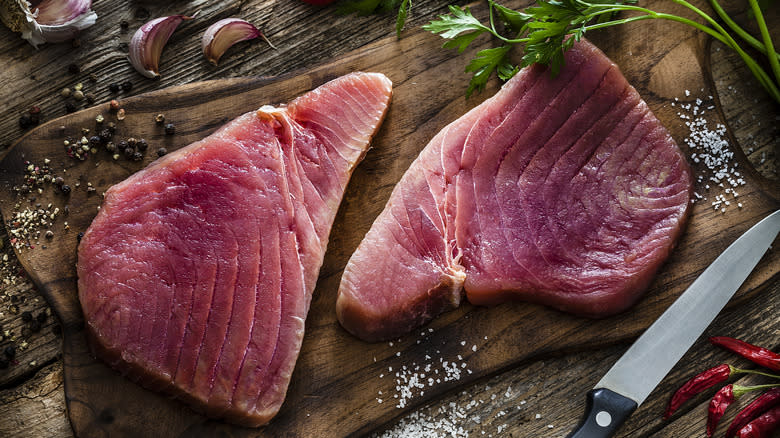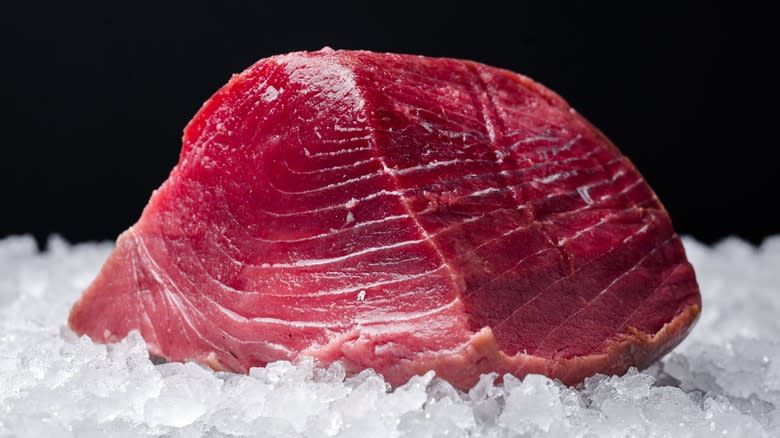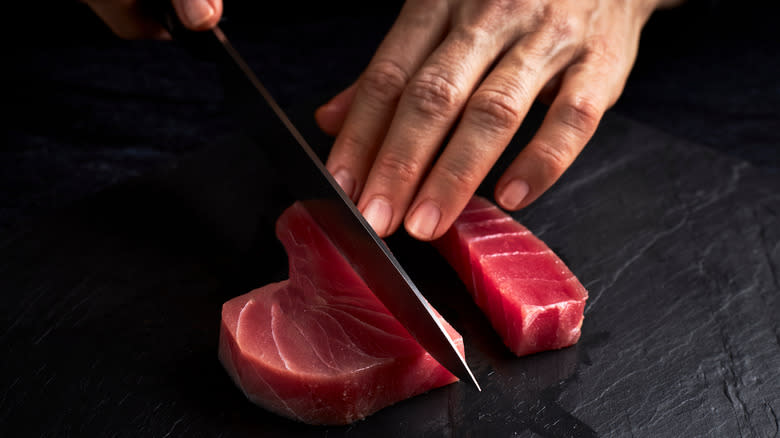How To Tell If Your Fresh Tuna Is Sushi-Grade

There are many people who wouldn't dare to prepare homemade sushi. Handling and consuming raw fish at home can seem a bit risky. However, if you are feeling brave and tempted to try it out, and would like to pick up some fresh tuna, how can you tell if it actually is sushi-grade?
Well, first off, sushi-grade fish is merely a marketing term. Some fishmongers will use it to indicate that their fish is fresh, but it's largely an unregulated term. The FDA doesn't have any regulations regarding the use of sushi grade on labels, nor are there any rules on what makes a fish sushi grade. However, the FDA does provide guidance on how to safely handle fish that will be eaten raw, namely freezing it at super low temperatures. Unfortunately, we can't pick up a tuna filet and freeze it in hopes of killing parasites; the fish must be frozen no more than eight hours after being caught, and conventional freezers just don't get cold enough to be safe -- at least -31 degrees Fahrenheit.
However, tuna usually doesn't need to be frozen for safety reasons, but because of demand, it usually is to maintain freshness. If you're looking for sushi-grade tuna, opt for sustainable tuna that's been caught by a U.S.-based fishery that uses pole-and-line or trolling lines. If you somehow stumble across fresh tuna filet at your local market and are willing to give it a shot, here's how to tell if your fresh tuna is sushi-grade.
Read more: 12 Underrated Types Of Fish You Should Try At Least Once
Look For Signs Of Freshness And Ask Your Fishmonger Questions

Don't expect to find sushi-grade raw fish at your local Wegmans or Kroger; you're better off heading to a specialty fish market where they will have more confidence in whether you can consume their products raw. But don't fear buying fresh fish -- if you're at the market, there are a few red flags to look out for when buying fresh fish. A filet should look fresh, i.e. have no discoloration or dry edges. For a whole fish, it should be displayed on a thick bed of ice and the eyes should be clear, not cloudy. Ask your fishmonger for any information regarding how long the fish has been out for and how it was sourced. Any seafood that's safe for eating should smell like nothing. It should smell fresh, like seawater but it shouldn't smell fishy, so if it smells even a bit off, cook it immediately or toss it. Color is also a good determiner of freshness, especially with tuna. Avoid tuna that looks bright red, as it's been treated with carbon monoxide to prevent discoloration. This kind of tuna is difficult to determine if it's gone bad. Fresh tuna should be a deep purplish maroon color.
Besides any physical indicators of freshness, there's the price to consider. Freshness costs money so your fresh, sushi-grade tuna will probably be more expensive than tuna filets from the grocery store, especially if it's been flown in from where it's caught.
Preparing Sushi-Grade Tuna At Home Requires Care

Once you've picked out your fresh tuna and purchased it, transport it home on ice and either get it into the refrigerator or freeze it if it hasn't been frozen already: The colder the better and safer your tuna will be. Ideally, you should use it on the day of purchase. Filleting any fish yourself will give you greater control over sanitary conditions than if it were done at the fish market, but depending on the type of tuna, it can be a very large fish, so it's likely the fishmonger will have done this for you, and you will have bought filets. To minimize the risk of cross-contamination while preparing your fish, make sure everything is sanitized, from your cutting board to your fish scaler and knives. Keep an eye out for worm-like parasites as you prepare your fish; some are visible to the naked eye. If your fish has been frozen according to the FDA regulations they should be dead and can be removed by you.
You can use your fresh tuna for tuna tartare or a light bowl of tekka don no poke, or even try rolling your own sushi like a pro.
Read the original article on Daily Meal.

